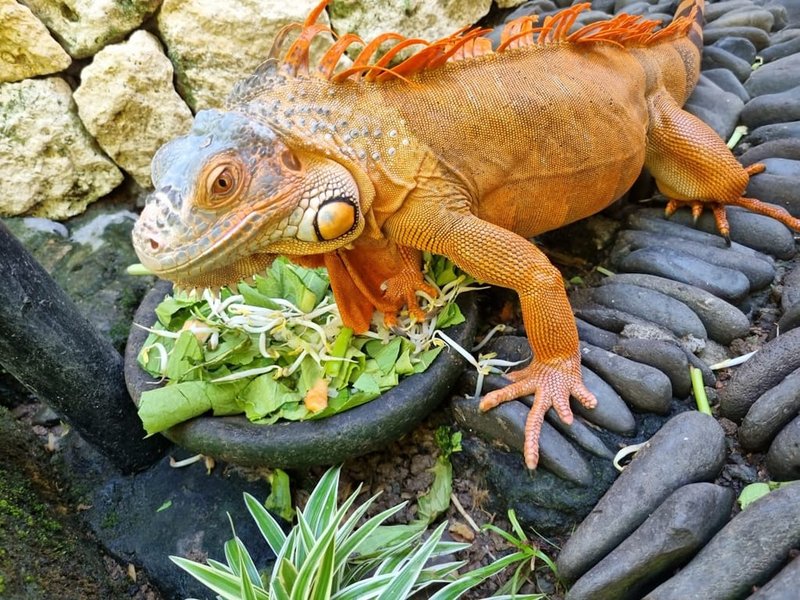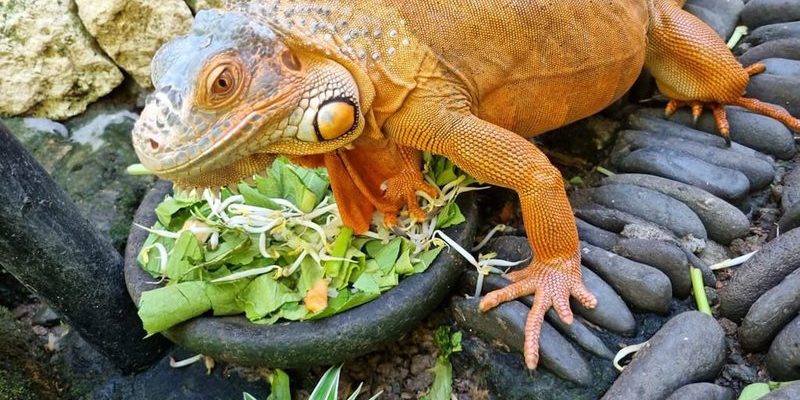
Think of a red iguana’s diet as a balanced meal prepping plan. Much like how you wouldn’t want to eat only junk food, a red iguana thrives on a variety of nutrients to stay healthy. Their diet mainly consists of leafy greens, fruits, and vegetables. This isn’t just about filling their stomachs; it’s about giving them the right fuel for their active lifestyle. So, grab a cup of coffee, and let’s explore what these colorful reptiles chow down on!
The Importance of a Balanced Diet for Red Iguanas
To understand what a red iguana eats, it’s essential to grasp why a balanced diet is important. Just like us, iguanas need a mix of nutrients to thrive. A healthy diet helps them with growth, metabolism, and maintaining a robust immune system. A red iguana that’s well-nourished will show vibrant colors, have a healthy appetite, and maintain a good weight.
Red iguanas are primarily herbivores, which means they rely heavily on plant matter. Leafy greens are particularly vital. Vegetables such as collard greens, mustard greens, and dandelion greens should be staples in their diet. Fruits can be offered but should be given in moderation due to their higher sugar content. Including a variety of food ensures that they receive essential vitamins and minerals, such as calcium and phosphorus, that support bone health and overall vitality.
If iguanas don’t get the right nutrients from their diet, they can develop health issues such as metabolic bone disease. This can weaken their bones, making them prone to fractures. So, it’s crucial to be mindful of what you’re serving up. A diverse selection will help mimic their natural diet, which is essential for their well-being.
What Foods Are Safe for Red Iguanas?
Now that we know the importance of a balanced diet, what exactly should you feed your red iguana? Here’s a list of foods that are safe and nutritious for these reptiles:
- Leafy Greens: Collard greens, kale, and turnip greens.
- Vegetables: Bell peppers, zucchini, and cooked sweet potatoes.
- Fruits: Mango, strawberries, and figs (in moderation).
- Flowers: Hibiscus and dandelions (safe and nutritious!).
Offering a mix of these foods regularly will ensure your iguana gets a well-rounded diet. It’s like being a chef in your own kitchen, experimenting with different recipes while making sure they’re getting the nutrients they need.
You might be wondering about the proportions. A good rule of thumb is to fill about 80% of their diet with leafy greens and vegetables, while the remaining 20% can come from fruits and flowers. This balance helps to avoid issues related to high sugar intake and keeps their system running smoothly.
How Often Should You Feed a Red Iguana?
Wondering how often to feed your red iguana? The answer can vary based on their age. Baby iguanas tend to eat more frequently than adults. Hatchlings and young iguanas should be offered food daily to support their growth. As they mature, you can scale back the feeding to every other day.
For adult red iguanas, a feeding schedule of about 3-4 times a week is sufficient. Always keep an eye on their body condition and adjust the feeding frequency and portions as needed. Just like us, iguanas communicate through their body language. If they seem overly hungry, you might need to increase their food intake slightly.
Also, don’t forget about hydration! Fresh, clean water should always be available, and you can also mist their environment to help keep their skin healthy and to encourage them to drink.
Supplements: Do Red Iguanas Need Them?
While a varied diet can provide most of the nutrients a red iguana needs, sometimes they might require a little extra help. This is where supplements come into play. Calcium and vitamin D3 are particularly important for iguanas because they help prevent metabolic bone disease.
You might be thinking, “How do I give supplements?” It’s simple! Many owners dust their iguana’s food with a calcium powder a few times a week. When doing this, make sure to avoid over-supplementing, as too much can be harmful.
If you’re unsure about the right amounts, consulting with a veterinarian who specializes in reptiles is always a smart move. They can help tailor a dietary plan based on your iguana’s specific needs.
Avoiding Foods That Are Harmful
Just as there are foods that are good for red iguanas, there are also those you should steer clear of. Some common ones include:
- Iceberg lettuce: It has little nutritional value.
- Avocado: It contains a toxin that can be harmful.
- High-fat foods: Such as nuts and seeds, should be avoided.
It’s crucial to remember that not all plants are safe. Some can even be toxic. Always double-check before introducing a new food item into their diet. Think of it as a treasure hunt—researching and discovering the best possible treats for your iguana while avoiding the pitfalls.
Even though it might seem overwhelming at first, knowing which foods to avoid can save you from future headaches and keep your scaly friend healthy and happy.
Feeding Behavior: Observing Your Iguana
Every red iguana has its own personality, and observing their feeding behavior can be quite enlightening. Some might be enthusiastic eaters, while others can be a bit picky. This can give you vital clues about their preferences and health.
If your iguana isn’t eating, it could signal stress, illness, or even boredom with their food options. Experimenting with different greens and fruits might spark their interest. However, if you notice a drastic change in appetite or behavior, it’s a good idea to consult a vet.
Honestly, the bond you form while figuring out what makes your iguana tick is a rewarding experience. You may find yourself learning their likes and dislikes, making feeding time an engaging part of your daily routine.
Feeding a red iguana may seem like a small part of their care, but it’s foundational for their overall well-being. By providing a diverse and nutritious diet—filled with leafy greens, safe vegetables, and the occasional fruit—you can ensure your iguana thrives.
Remember, watching and adapting to your iguana’s preferences and health needs is part of the journey. It might take a little time to find the right balance, but the effort is worth it for such a beautiful companion. With a little practice and some trial and error, you’ll find the perfect menu for your red iguana, keeping it healthy, happy, and bursting with energy!

